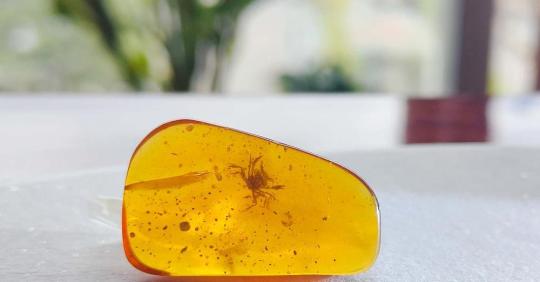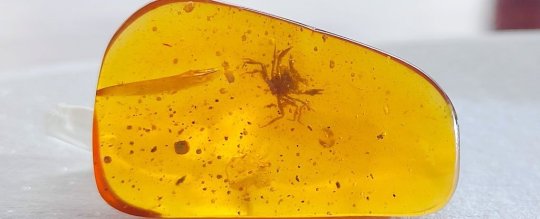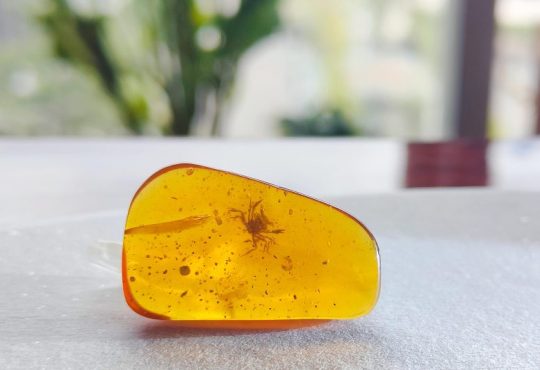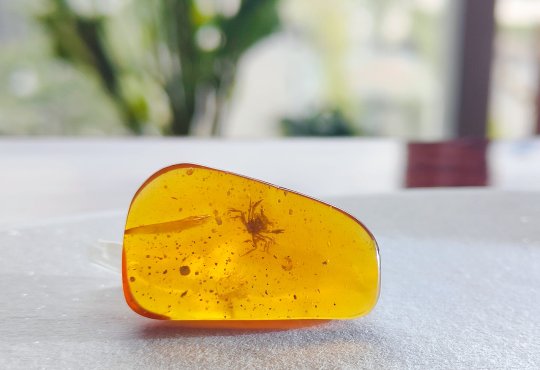#cretapsara athanata
Text

BOW DOWN TO THE ANCIENT ONE
52K notes
·
View notes
Note
Primitive crabs first appeared in the Carboniferous Period between 360 to 300 million years ago.

this is the best possible way I could have received crabs today, thank you!! i went and looked up "carboniferous crab" because why wouldn't I and learned about cretapsara athanata, which was apparently around in the cretaceous (so, much later, but still 100 million years ago) and identified by a specimen trapped in amber in 2021
look at this fella!

jurassic park but for crabs only, drafting the movie pitch for when the writer's strike is over
26 notes
·
View notes
Text

Cretapsara athanata: il primo granchio risalente all’epoca dei dinosauri trovato nell’ambra.
FOTOGRAFIA DILIDA XING
0 notes
Photo

This crab has been named Cretapsara athanata, which means ‘immortal spirit of the clouds and waters’. It has been preserved in amber for 100 million years.
95 notes
·
View notes
Text
cretapsara athanata
cretapsara athanata
1 note
·
View note
Text
Kehribar İçindeki Yengeç
Kehribar İçindeki Yengeç
Kehribar fosilleri, soyu tükenmiş organizmaların, aksi takdirde erişilemeyecek olan anatomisi, biyolojisi ve ekolojisinin anlık görüntülerini sağlar. Kehribardaki en iyi bilinen fosiller karasal eklembacaklılardır -esas olarak böceklerdir- oysa suda yaşayan organizmalar nadiren bulunur. Kehribar silleri özellikle de küçük, omurgasız hayvan gruplarının evrimi hakkında…

View On WordPress
0 notes
Text

Cretapsara athanata
Cretapsara athanata – вимерлий вид крабів з родини Cretapsaridae, знайдений у шматку бурштину з півночі М’янми, що датується віком біля 99 млн. років (крейдовий період).
Повний текст на сайті "Вимерлий світ":
https://extinctworld.in.ua/cretapsara-athanata/
#cretapsara#cretaceous#paleontology#paleoart#палеоарт#палеонтологія#prehistoric#доісторичні істоти#вимерлі тварини#extinct animals#cretaceous period#myanmar#cretapsaridae#made in ukraine#ukraine#ukraineposts
2 notes
·
View notes
Text
https://href.li/?http://www.sci-news.com/paleontology/cretapsara-athanata-10190.html
1 note
·
View note
Text
Adorable Crab🦀Encased in Amber Is Among The Oldest True Crabs Ever Found

A tiny crab scuttled around a forest floor, in the time of dinosaurs, minding its own business, when a blob of tree goop oozed onto it. Despite its struggles – during which it may have amputated its own leg in a futile attempt at escape – the sticky tree resin hardened around it, entombing it for almost 100 million years.
"When I saw it for the first time I could not believe my eyes," Harvard paleontologist Javier Luque said. "This spectacular crab looks so modern, like something you may find in [British Columbia] flipping rocks, but it is actually quite old and different from anything seen before, fossil or alive."
Micro-CT scans revealed the amber had preserved the 5-millimeter crab to an exceptional level – even protecting the crab's delicate setae (invertebrate 'hairs') around its slightly open mouthparts.
Fragile gills and intricate compound eyes were still intact for the researchers to examine, and a clear molting line indicated the crab was still alive when drowned in tree resin. One of its legs is detached from its body, possibly due to limb autotomy.
"Cretapsara athanata is the most complete fossil crab ever discovered," said Luque. He and his colleagues named the crab for "the immortal Cretaceous spirit of the clouds and waters" from South Asian mythology.
0 notes
Text
Descoberto o primeiro caranguejo da era dos dinossauros totalmente preservado

Um estudo publicado em 20 de outubro de 2021, na Science Advances, uma equipe internacional de pesquisadores descreve o primeiro caranguejo da era dos dinossauros cretáceos preservado em âmbar.
O registro fóssil do caranguejo se estende de volta ao início do período Jurássico, há mais de 200 milhões de anos. Infelizmente, os fósseis de caranguejos não-marine são esparsos e em grande parte restritos a pedaços de carapaças animais – garras e pernas encontradas em rochas sedimentares. Isso é até agora com a descoberta de Cretapsara athanata.

Cretapsara athanata.
Crédito: Xiao Jia (Museu Âmbar Longyin)
A descoberta

1.C. athanata Luque gen. et sp. nov., um caranguejo eubraquiano de aparência moderna em âmbar birmanês. (A a D) Holotipo LYAM-9. (A) Amostra âmbar inteira com inclusão de caranguejo na visão ventral. (B) Close-up da carapaça ventral. (C) Amostra âmbar inteira com inclusão de caranguejo na visão dorsal. (D) Close-up de carapaça dorsal. As setas brancas em (B) e (D) indicam a quinta perna esquerda ou pereópode destacado.
Crédito: Imagens e figura por Javier Luque e Lida Xing
O estudo utilizou microCC para examinar e descrever a espécie como "athanata de Cretapsara", que é um caranguejo de aparência moderna mais antigo (aproximadamente 100 milhões de anos) sendo o caranguejo como o fóssil mais completo já descoberto até hoje. É rivalizada com a completude pela misteriosa "Callichimaera perplexa", um parente muito distante apelidado de ornitorrinco do mundo dos caranguejos.
A preservação impressionante de Callichimaera incluía tecidos moles e partes delicadas que raramente fossilizam. Tanto Cretapsara quanto Callichimaera são novos ramos na árvore de caranguejos que viveram durante a Revolução do Caranguejo Cretáceo, um período em que os caranguejos se diversificaram em todo o mundo e os primeiros grupos modernos se originaram enquanto muitos outros desapareceram.
"O espécime é espetacular, é único. É absolutamente completo e não falta um único cabelo no corpo, o que é notável",disse Javier Luque
Os verdadeiros caranguejos, ou Brachyura, são um grupo icônico de crustáceos cuja notável diversidade de formas, riqueza de espécies e importância econômica inspiraram celebrações e festivais em todo o mundo
Como ficou tanto tempo preservado?
A explicação mais provável é que as brânquias permitem que animais aquáticos respirem na água. Mas os caranguejos conquistaram com sucesso e independentemente aterra, água salgada e água doce pelo menos doze vezes desde a era dos dinossauros. Por terem adquirido a capacidade de viver em diversos ambientes as suas brânquias evoluíram para para um tecido com função semelhante ao pulmão humano, permitindo assim que eles respirassem dentro e fora da água. Cretapsara, no entanto, não tinha tecido pulmonar, apenas brânquias bem desenvolvidas indicando que o animal não estava completamente em terra.
"Agora estávamos lidando com um animal que provavelmente não é marinho, mas também não totalmente terrestre", disse Luque. "No registro fóssil, os caranguejos não-marine evoluíram há 50 milhões de anos, mas este animal tem o dobro dessa idade."
A pesquisa sobre o fóssil

Reconstituição em 3D do caranguejo que viveu na época dos dinossauros (Foto: Elizabeth Clark and Javier Luque)
Um grupo de cientistas liderados pelo coautor Lida Xing, da Universidade de Geociências da China, em Pequim, fez micro tomografias do fóssil, que está alojado no Museu Âmbar Longyin, em Yunnan, China. Os exames criaram uma reconstrução tridimensional completa da preservação requintada do animal permitindo que Luque, Xing e sua equipe vissem o corpo completo do animal, incluindo tecidos delicados, como as antenas e as partes bucais forradas com cabelos finos. Surpreendentemente, eles descobriram que o animal também tinha brânquias.
Os pesquisadores hipótesem que Cretapsara, medindo a cinco milímetros de extensão da perna, era um caranguejo juvenil de água doce para espécies anfíbias. Ou, que o animal é talvez um caranguejo juvenil semi-terrestre migrando para a terra da água como ocorre com os icônicos caranguejos vermelhos da Ilha de Natal, onde caranguejos-mãe que habitam a terra liberam seus bebês no oceano, que mais tarde se espalham para fora da água de volta à terra. Eles ainda hipótesem que, como os caranguejos encontrados em âmbar do Mioceno, Cretapsara poderia ter sido um escalador de árvores o qual justificaria a sua preservação total.
A pesquisa de Luque é centrada em entender por que as coisas evoluem para caranguejos, e sua evolução e diversificação ao longo do tempo levando às formas modernas vistas hoje. "Este estudo está empurrando o tempo de origem de muitos desses grupos de volta no tempo. Cada fóssil que descobrimos desafia nossos preconceitos sobre o tempo e o local de origem de vários organismos, muitas vezes nos fazendo olhar mais para trás no tempo", disse Luque.
A escolha do nome
Os pesquisadores escolheram o nome Cretapsara athanata, que significa o espírito cretáceo imortal das nuvens e águas, para homenagear o Cretáceo, durante o qual este caranguejo viveu, e Apsara, um espírito das nuvens e águas da mitologia sul e sudeste da Ásia. O nome da espécie é baseado em "athanatos", imortal, referindo-se à sua preservação realista como se "congelada no tempo" na cápsula do tempo que é âmbar.
Fonte: Texto traduzido parcialmente do original em scitechdaily
Read the full article
0 notes
Text
Adorable crab encased in amber is among the oldest true crabs ever found
https://sciencespies.com/nature/adorable-crab-encased-in-amber-is-among-the-oldest-true-crabs-ever-found/
Adorable crab encased in amber is among the oldest true crabs ever found
A tiny crab scuttled around a forest floor, in the time of dinosaurs, minding its own business, when a blob of tree goop oozed onto it. Despite its struggles – during which it may have amputated its own leg in a futile attempt at escape – the sticky tree resin hardened around it, entombing it for almost 100 million years.
“When I saw it for the first time I could not believe my eyes,” Harvard paleontologist Javier Luque said. “This spectacular crab looks so modern, like something you may find in [British Columbia] flipping rocks, but it is actually quite old and different from anything seen before, fossil or alive.”
Micro-CT scans revealed the amber had preserved the 5-millimeter crab to an exceptional level – even protecting the crab’s delicate setae (invertebrate ‘hairs’) around its slightly open mouthparts.
Fragile gills and intricate compound eyes were still intact for the researchers to examine, and a clear molting line indicated the crab was still alive when drowned in tree resin. One of its legs is detached from its body, possibly due to limb autotomy.
“Cretapsara athanata is the most complete fossil crab ever discovered,” said Luque. He and his colleagues named the crab for “the immortal Cretaceous spirit of the clouds and waters” from South Asian mythology.
Amber is like a time capsule that preserves organisms like frozen in time. While most fossils in amber are land-dwelling animals—principally insects—, aquatic organisms such as crabs are extremely rare! #amber #jurassicpark #Cretaceous #Crabs Photo by @LidaXing1982 3/n pic.twitter.com/5JOoboMjnX
— Javier Luque (@JaviPaleobio) October 20, 2021
The fossil was found in a Kachin Province of Myanmar, a region now sadly embroiled in sociopolitical conflict. In recognition and to raise awareness of the unfortunate role the fossil trade is playing in funding the devastating conflict, Luque and colleagues declared they will only explore fossils from before 2017, when the current conflict resumed.
This amber was legally purchased by the Longyin Amber Museum in 2015. Plant tissues and insect poop within it suggest the amber formed on or near the forest floor, an assumption backed up by the lack of sand and layers that would have indicated the amber met water at some point.
However, the stunningly preserved gill anatomy of the crab fossil did not show any signs of land adaptation, like the lung tissue we see in terrestrial crabs today, so the crab was likely amphibious, the team concluded. It possibly lived in freshwater pools in the forest, estuaries, or migrated from the sea like Christmas Island red crabs.
One of the most remarkable surprises of the new fossil discovery is the preservation of tiny gills in #3D , revealed via a microCT scan. Mind-blowing! 🤯 What can we learn from the exceptional preservation of this crab in amber? #VirtualPhotography #OA https://t.co/NyXXTQj4Ax pic.twitter.com/8HI7k7EjXR
— Javier Luque (@JaviPaleobio) October 20, 2021
Crab fossils extend back more than 200 million years ago, displaying an incredible diversity in forms since then. This new find from the Early Cretaceous (~99 million years ago) has a mix of early and later evolved features that indicate crabs were already established in non-marine environments back then.
“This crab is telling us a very interesting story about the tree of life of crabs,” said Luque. “There is a lot of excitement about crab evolution because evolution has produced crab-like forms, known as carcinization, many times independently.”
And here is a stunning #3D video #animation of tiny Cretapsara athanata that will blow your mind! Because every day is #CrabDay 🦀🙌 Click here👇 #SciComm #sciart #paleoart #InsertAnInvert #Science #nature #art @HarvardOEB @NSF @NSERC_CRSNG 8/n pic.twitter.com/eOWWv1XO2F
— Javier Luque (@JaviPaleobio) October 20, 2021
C. athanata is one of the oldest and most complete finds belonging to the group of true crabs, Brachyura (as opposed to ‘false crabs’ like hermit crabs) – the same group as the crabs still scuttling about today. But there was a massive 50 million year gap between when molecular and fossil evidence indicated the split between marine and terrestrial/freshwater crabs took place.
“Cretapsara bridges the gap between the molecular DNA split of non-marine crabs from their marine kins (~130 million years ago) and their oldest known fossils (~75–50 million years ago),” explained Luque on Twitter. It also “tells us that crabs have conquered land and freshwater more than 12 times independently!”
Evolution sure loves messing with crabs.
This research was published in Science Advances.
#Nature
0 notes
Text
I ricercatori scoprono il primo granchio dell'era dei dinosauri perfettamente conservato nell'ambra
I ricercatori scoprono il primo granchio dell’era dei dinosauri perfettamente conservato nell’ambra
Cretapsara athanata: Il primo granchio in ambra dell’era dei dinosauri.
I fossili intrappolati nell’ambra forniscono un’istantanea unica dell’anatomia, biologia ed ecologia degli organismi estinti. I fossili più comuni trovati nell’ambra, che è formata da resina trasudata dalla corteccia degli alberi, sono animali terrestri, soprattutto insetti. Ma in occasioni molto rare gli scienziati scoprono…

View On WordPress
0 notes
Text
Q: Would you like to see a cretacious period baby crab, mon capitaine?
Picard: No.
Q, snaps his fingers:
Picard: I don't see it.
Q: That's the point. It's on your shoulder and you can't see it. <3 *snaps his fingers and the Enterpise E is now somewhere else*
Madden: Captain, I realize this is the least of our problems but--
Picard: what is it, number one?
Madden: that's most likely a baby Cretapsara athanata and they can climb.
16 notes
·
View notes
Text
First dinosaur era crab fully preserved in amber discovered
Researchers describe the first crab from the Cretaceous dinosaur era preserved in amber. The study used micro CT to examine and describe Cretapsara athanata, the oldest modern-looking crab (approximately 100 million years old) and the most complete fossil crab ever discovered.
First dinosaur era crab fully preserved in amber discovered syndicated from https://triviaqaweb.blogspot.com/
0 notes